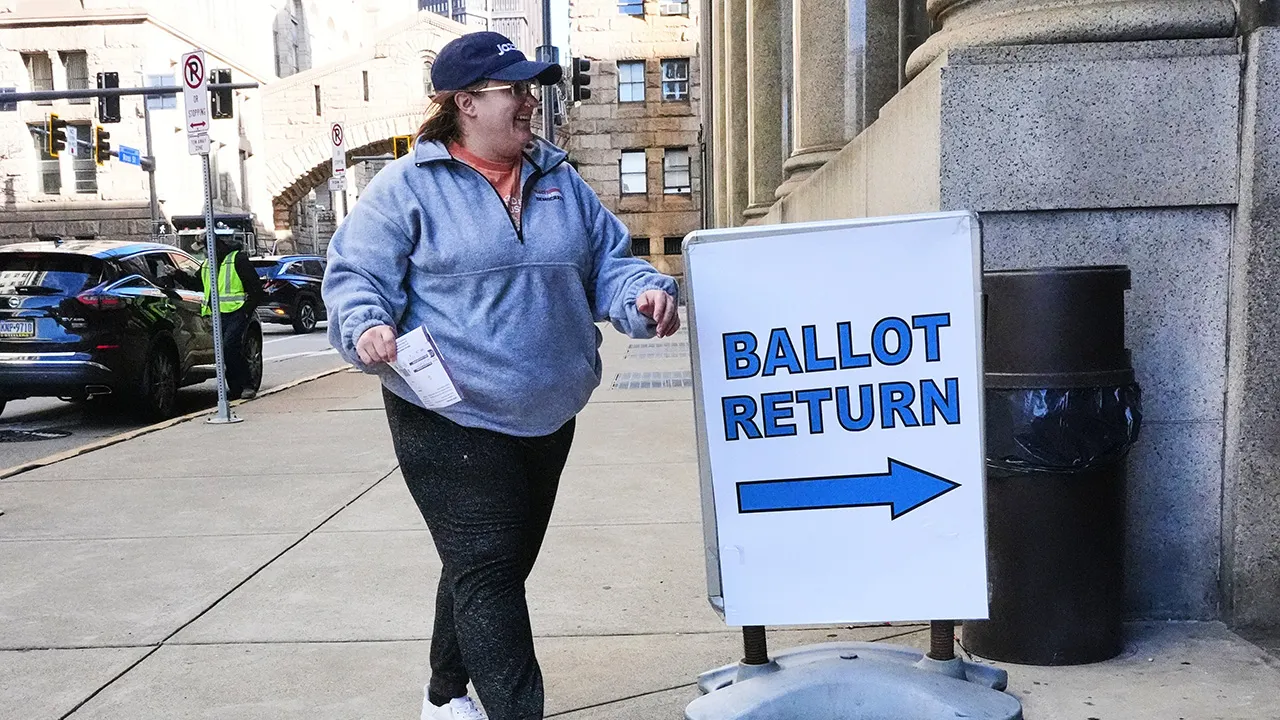Vermont
Guster’s Ryan Miller talks new album, Vermont show, ‘Safety Not Guaranteed’ musical

Ryan Miller is proud of “Ooh La La,” the new album from his long-running rock band, Guster. He’s excited at the prospect of Guster’s concert this weekend at the Shelburne Museum, not far from Miller’s home in Williston.
Recording albums and playing concerts are, of course, what Guster does. “Ooh La La” is the band’s ninth studio album. The Shelburne concert will be the latest of a couple thousand shows Guster has played since forming more than three decades ago.
Miller is, however, taking on one big project unlike any he’s done before. He’s writing the music and lyrics for an off-Broadway musical based on the 2012 film “Safety Not Guaranteed” that will open in previews in September at the Brooklyn Academy of Music (BAM). Miller wrote the soundtrack for that movie and has followed with more than a dozen film scores. But a musical? That’s uncharted territory.
Miller called himself a “51-year-old dude/neophyte” in the world of New York musicals who doesn’t fully know what he’s doing as he works with seasoned Broadway and off-Broadway veterans. He said he’s had nightmares about the musical failing. He likes to stretch himself for projects that keep him occupied for weeks or months at a time, but a musical that might take years to fully develop sounds daunting.
And exciting.
“It’s a fascinating process,” Miller said. “I am just learning so much in real time.”
The flow of ‘Ooh La La’
Miller spoke June 21 with the Burlington Free Press on his houseboat on Lake Champlain. If a houseboat sounds like another case of rock-star excess, know that it’s a 57-year-old houseboat Miller bought with three friends for $3,000. It’s also more house than boat; like most abodes, it is incapable of locomotion.
The scruffy floating retreat fits Miller’s persona to a T. For his chat with the Free Press, he wore a cartoonish T-shirt touting the Hudson Valley, flannel pants festooned with floral prints and vibrant socks bearing the logo for the soft drink Topo Chico. His hair maintained its perpetually tousled status.
Nothing about Guster is so haphazard. “Ooh La La,” which came out May 17, is a meticulous-sounding record, brimming with brightly toned tunes with soft edges of melancholy. Miller said the lyrics reflect his own experiences but ideally bypass the “hyper-personal” to let the listener in on his perspective.
Miller, who’s married with two teenagers, has heard from fans who say it’s amazing that Guster can still relate to where they are in life after three decades.
“When that happens, that has something to do with why we’ve been able to maintain our place” of popularity with fans, Miller said, noting that the band sold out the famed Ryman Auditorium in Nashville in one day and the Red Rocks Park & Amphitheatre outside Denver in three days. “I do think we are in conversation with people.”
“Ooh La La” is a very Vermont-y record, and not just because Miller and bandmate Luke Reynolds, an Addison County native, live in Vermont. Grammy-winner Rich Costey, a Waterbury native, mixed, co-engineered and co-produced the songs “When We Were Stars” and “All Day.” University of Vermont graduate Peter Katis mixed most of the album’s songs and played keyboards. Part of the album was recorded in southern Vermont at Guilford Sound.
The Shelburne Museum performance will be very Vermont-y as well. “Let’s go full Vermont as much as possible,” Miller said of his approach to the concert.
Guster will be joined onstage by James Kochalka Superstar, the Burlington band led by the big personality of the vocalist/cartoonist, and the Zeno Mountain Band from Zeno Mountain Farm in Lincoln that supports people with disabilities. Miller is counting on nice weather as opposed to last summer, when Guster’s plans to perform on the Shelburne Museum lawn were continually washed out.
“We need to go back to the scene of the crime,” he joked.
Music for “Safety Not Guaranteed’
Miller will spend much of the summer cramming to get “Safety Not Guaranteed” ready for its BAM run from Sept. 17-Oct. 20. He became involved with the film a dozen years ago after striking up a friendship with Colin Trevorrow, the director of that time-travel-themed movie who at the time lived in Burlington. (Trevorrow, a Guster fan who would go on to direct films including “Jurassic World,” now lives in London.) That well-received film and score launched Miller’s career in writing music for movies, most recently for the Ilana Glazer comedy “Babes,” which came out the same day as “Ooh La La.”
Another Guster fan, Nick Blaemire, approached Miller with the idea of contributing music for a stage version of “Safety Not Guaranteed.” “My answer was, ‘Sure,’” Miller said, though he had no real idea what writing the songs for a musical might entail.
He traveled to New York and found that Blaemire, who’s writing the book for “Safety Not Guaranteed,” assembled several Broadway and off-Broadway actors and a guitar player to present a version of the production with Guster songs as placeholders. Miller said he was impressed by the narrative of the story but didn’t want “Safety Not Guaranteed” to be a jukebox musical framed by Guster songs, so he chose to write more than an hour’s worth of original songs for the production.
Miller said he’ll work on a film soundtrack for four to 12 weeks, but a multi-year musical is a different animal for someone who likes to take on a variety of projects. “I respect the medium,” he said, “but it’s not my workflow.”
He’s getting into the flow now as “Safety Not Guaranteed” makes its way to BAM’s 875-capacity Harvey Theater. Miller would like to see the show move to Broadway one day. “We’re not trying to be done with it at BAM,” he said.
“Safety Not Guaranteed” has already influenced Miller’s work with Guster. He said the band’s recent “We Also Have Eras” tour, which told the story of Guster in a theatrical-styled musical performance, was shaped in part by the work he’s doing on “Safety Not Guaranteed.”
“I almost felt like maybe we’re more of an art project than a band,” Miller said. “This sort of theater experience I’m having will remain conversant with the band.”
His work on film scoring, off-Broadway shows and presenting “super-special” shows with Guster “gets kind of gooey,” blending in one creative pot, according to Miller.
“It helps me to recontextualize what the band can be,” he said.
If you go
WHAT: Guster with James Kochalka Superstar and the Zeno Mountain Band
WHEN: 6 p.m. Saturday, June 29
WHERE: Shelburne Museum
INFORMATION: $55 in advance, $59 day of show; free for children 12 and under. www.highergroundmusic.com
Contact Brent Hallenbeck at bhallenbeck@freepressmedia.com.

Vermont
The Supreme Court hears challenges to Trump’s tariffs with Vermont ties – VTDigger

This story is based on stories by Violet Jira published on Nov. 5, 2025 by NOTUS, one before and one after the oral arguments.
The U.S. Supreme Court heard arguments Wednesday related to the legality of President Donald Trump’s use of tariffs in a case that won’t just be deciding the fate of his trade policy, but also could redefine the limits of presidential economic power.
The hearing involved appeals in a pair of cases that challenge the Trump administration’s use of the International Emergency Economic Powers Act, including one with Vermont ties. Trump has used the law to bypass procedural norms and place extensive tariffs on enemies and trading partners alike without authorization from Congress.
READ MORE

One of the cases includes Terry Precision Cycling, or Terry Cycling, a women’s cycling apparel company, as one of five small business plaintiffs. The group sued Trump and his administration in the U.S. Court of International Trade in April. In May, a panel of three federal judges struck down most of the president’s tariffs. The U.S. Court of Appeals for the Federal Circuit also largely backed the plaintiffs. The case was combined with another brought by private organizations impacted by the tariffs in Wednesday’s arguments in the Supreme Court.
The court also heard from a representative of 12 attorneys general, including Vermont Attorney General Charity Clark, who sued on similar grounds.
During the arguments, Solicitor General D. John Sauer defended the Trump administration’s actions — sometimes by contradicting the president.
Sauer faced a slew of skeptical inquiries from the justices who seemed to take issue with many of the Trump administration’s arguments, including that the president has broad authority to respond to international emergencies, Congress delegated the presidency this power, and tariffs are not taxes.
Since the Constitution gives Congress the power to tax, the claim that tariffs are not a tax was central to Sauer’s argument, despite the fact that the president has framed them as revenue-raising.
“We don’t contend that what’s being exercised here is the power to tax,” Sauer said. “It’s the power to regulate foreign commerce. These are regulatory tariffs. They are not revenue raising tariffs.”
Trump regularly says tariffs are making the country richer. And earlier this year, the White House floated using tariffs as a revenue raiser to offset the cost of the One Big Beautiful Bill Act.
Justice Sonia Sotomayor, who spoke recently at the University of Vermont, made clear that she didn’t buy Sauer’s argument on tariffs versus taxes.
“You say tariffs are not taxes, but that’s exactly what they are,” she said. “They’re generating money from American citizens, revenue.”

‘Simply implausible’
How the justices decide the case will have major implications not just for Trump’s agenda but for how much unilateral power presidents have to regulate commerce.
During the arguments, Justice Neil Gorsuch leaned heavily into the question of congressional authority. He seemed to take issue with the fact that it would be difficult for Congress to reclaim that authority should the Supreme Court give the Trump administration what it was asking for.
“Congress, as a practical matter, can’t get this power back once it’s handed it over to the president. It’s a one way ratchet toward the gradual but continual accretion of power in the executive branch and away from the people’s elected representatives,” he argued.
Justice Amy Coney Barrett seemed skeptical of the scope of the reciprocal tariffs Trump has placed on dozens of countries, allies and trading partners alike.
“Is it your contention that every country needed to be tariffed because of threats to the defense and industrial base? I mean, Spain, France? I mean, I could see it with some countries, but explain to me why as many countries needed to be subject to the reciprocal tariff policy as are,” she asked.
The small businesses were represented by attorney Neal Katyal. He argued that tariffs are, in fact, a tax, and that the Trump administration was exceeding the authority Congress intended to give to the executive branch when it passed the International Emergency Economic Powers Act.
“It’s simply implausible that in enacting IEEPA, Congress handed the president the power to overhaul the entire tariff system and the American economy in the process, allowing him to set and reset tariffs on any and every product from any and every country at any and all times,” Katyal said.
“And as Justices Gorsuch and Barrett just said, this is a one-way ratchet,” he continued. “We will never get this power back if the government wins this case. What president wouldn’t veto legislation to rein this power in and pull out the tariff power?”
The Supreme Court has until the end of its term next summer to make a decision, but the case has so far been on an expedited track, leading some experienced court watchers to expect a decision before the end of the year.
Other routes for tariffs
The White House has projected confidence in its ability to win the case — press secretary Karoline Leavitt said officials believe the Supreme Court will rule in their favor. Still, contingency plans have long been in the works.
“The White House is always preparing for plan B,” she said at a briefing. “It would be imprudent of the president’s advisers not to prepare for such a situation. With that said, we are 100% confident in the president and his team’s legal argument and the merits of the law in this case, and we remain optimistic that the Supreme Court is going to do the right thing. The importance of this case cannot be overstated.”
Trump has used the threat of tariffs in matters far beyond trade. The administration used a tariff investigation to pressure Brazil over its decision to prosecute former President Jair Bolsonaro. Trump attempted to use trade negotiations to stop Canada from backing Palestinian statehood. The threat of steep tariffs has been an essential leverage point in his peace negotiations between countries like India and Pakistan, as well as Russia and Ukraine.
The Supreme Court’s decision could stymie all of this.
Administration officials have indicated that even if they lose the case, they would find another way to levy tariffs.
There are multiple legal avenues to enact tariffs. Top Trump trade adviser Peter Navarro has signaled the administration was considering use of Section 122 and then Section 301 of the Trade Act of 1974, if use of the International Emergency Economic Powers Act is deemed unlawful.
Multiple trade experts NOTUS spoke to said this would be the most plausible course of action for Trump to keep his tariffs alive if the court rules against him.
Peter Harrell, who served as senior director for international economics and competitiveness in the Biden White House, said “the most obvious choice” for the White House to temporarily maintain tariffs would be to invoke Section 122. That would allow tariffs of up to 15% for as long as 150 days on countries whose trade with the U.S. is unjustifiably imbalanced.
“That, to me, looks like the sort of obvious, immediate stop gap they could pull to keep many of their tariffs in place for a couple of months while they figure out what the longer term plan is,” he said.
Section 301 of the trade act allows an administration to launch investigations into specific countries and implement tariffs based on the results of that investigation. There are already active Section 301 investigations into China, Brazil and Nicaragua; the latter two were started under the administration of President Joe Biden. The Trump administration could begin more of them, but the investigations take months and again open the administration up to the possibility of lawsuits.
Over the past few months, the Trump administration has expanded its use of Section 232 of the Trade Expansion Act of 1962, which allows him to put restrictions on the import of certain goods if they are found after an investigation to threaten national security.
But none of these powers is as expansive as the International Economic Emergency Powers Act, which the Trump administration has used to enact crushing tariffs with the stroke of a pen.
The International Economic Emergency Powers Act “only requires a finding of a national emergency, which is a more unilateral power within the president to make that determination,” said Everett Eissenstat, a partner at Squire Patton Boggs who represented the Trump administration on international trade matters as deputy director of the National Economic Council during Trump’s first term. “There’s no investigation, there’s no congressional consultation, it’s just a declaration of emergency, and that unleashes the power to regulate commerce, regulate importation.”
He added that there “were certainly more limitations” on Section 301 and Section 232.
If the Supreme Court were to rule in the Trump administration’s favor, it’s possible that the ruling wouldn’t just give the administration the legal go-ahead on current tariff policy, but open the door for the International Economic Emergency Powers Act to be used even more broadly than Trump is currently using it.
For the importers, business owners, consumers and taxpayers who are impacted by the president’s trade and tariff policy, a decision from the Supreme Court in either direction is unlikely to offer significant relief from the pressures of the Trump tariff economy.
“Unfortunately, if you’re a business, you can celebrate a Supreme Court win if that’s the way it goes, but you’re not going to be off the hook,” Riley said. “Trump will continue to impose tariffs, continue to impose costs on Americans, but he just won’t have the unlimited authority that he’ll have if the Supreme Court allows the IEEPA tariffs to remain in place.”
Vermont
Tracking Vermont’s 2025 election day results

BARRE, Vt. (WCAX) – Voters hit the polls across the country on Tuesday, weighing in on everything from high-stakes political races to municipal funding.
In Vermont, towns looked to their residents to approve a myriad of projects.
Across the state, Vermont voters considered ballot items pertaining to flood mitigation, infrastructure projects, and a new career center.
After a full workday and an evening of volunteering at the Barre Community Justice Center, Becky Wigg took to the polls.
“I moved here five years ago during the pandemic and really found my community,” said Wigg.
She voted yes to Barre’s $2.4 million flood-resilient housing project and the $3.3 million new public works building, which will be built out of the flood plain.
“I voted yes for the bonds because I believe in Barre. I want to live in a thriving community where everyone has a safe place to live, an affordable place to live, and we have the public services and resources that we need,” said Wigg.
Barre’s unofficial election results show both ballot items were approved.
“Really transformational projects, these are generational things that we’ve been trying to solve, and I’m very, very pleased that the voters showed their confidence in these projects and approved them,” said Barre City Manager Nicolas Storellicastro.
The Hinesburg Record reports that bond issues of repairing two flood-damaged bridges and installing a new well were approved.
Brighton approved their $9.6 million bond to upgrade the town’s wastewater system. Cabot approved spending a quarter million dollars on flood mitigation.
Plainfield’s request to borrow $600,000 as part of a $9 million project to build 40 new homes failed.
And so did Berlin’s bond to form a four-season rec center, as reported by the Times Argus.
Also on central Vermonters’ ballots was the option to build a $149 million new technical education center.
Central Vermont will need to pool results from different towns to find out if the career center will happen. They expect the results on that to come out on Thursday.
Copyright 2025 WCAX. All rights reserved.
Vermont
Vermont knocks off Western New England 75-68
-

 Milwaukee, WI1 week ago
Milwaukee, WI1 week agoLongtime anchor Shannon Sims is leaving Milwaukee’s WTMJ-TV (Channel 4)
-

 News1 week ago
News1 week agoWith food stamps set to dry up Nov. 1, SNAP recipients say they fear what’s next
-

 Culture1 week ago
Culture1 week agoVideo: Dissecting Three Stephen King Adaptations
-

 Seattle, WA4 days ago
Seattle, WA4 days agoESPN scoop adds another intriguing name to Seahawks chatter before NFL trade deadline
-

 Seattle, WA1 week ago
Seattle, WA1 week agoFOX 13’s Aaron Levine wins back-to-back Jeopardy! episodes
-

 San Diego, CA1 week ago
San Diego, CA1 week agoAdd Nick Hundley, Ruben Niebla to list of Padres’ managerial finalists
-

 Business6 days ago
Business6 days agoCommentary: Meme stocks are still with us, offering new temptations for novice and unwary investors
-

 News1 week ago
News1 week agoHow and Where the National Guard Has Deployed to U.S. Cities
















